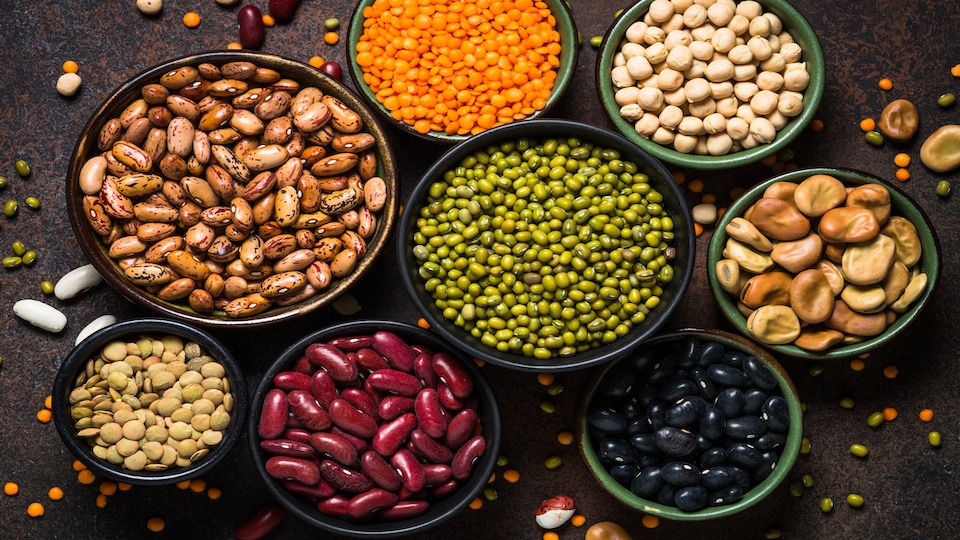If you’ve been involved in any discussion on this issue, you’ve probably heard that plant foods which contain amino acids (the building blocks of protein) need to be combined in order to form a complete protein. The idea is that plants like beans, grains, and legumes contain most, but not all, of the essential amino acids. Those particular amino acids are called “essential” because they are the ones that humans cannot make… making them a necessary dietary ingredient. As the story goes… in order to get them all, you need to combine plant foods in such a way that your plate has a “complete” protein on it, one that contains all of the essential amino acids.
The notion described above is actually a long-held myth — the truth is that vegetarians (and vegans) can get more than enough protein in their diets without complicated “protein combining” methods. Here’s how…
-JL
One of the most frequent questions regarding a meatless diet is “But, where do you get your protein?” Unlike the passionate assertions of meat-lovers everywhere, protein doesn’t just come from meat. If you follow a meatless or less meat diet, you’ll want to incorporate these delicious and nutritious plant proteins to ensure that you receive adequate nutrients and maintain a healthy lifestyle.
Quinoa
Contrary to popular belief, quinoa is not actually a whole grain, but a seed. It is gluten-free, and one cup of cooked quinoa contains 8 grams of protein which is more than any other grain. Plus, it also has a better amino acid profile and higher protein to fat and carb ratio than other grains. If you need a filler for any meal, quinoa is the way to go. It is incredibly versatile and has a mild nutty flavor that blends well with any toppings or sauces. Use quinoa as a grain salad base, or as a replacement to oatmeal or rice and enjoy the unique crunchy texture.
Lentils
Red and green lentils are not only excellent for you, but they are an incredibly inexpensive source of protein which makes them a great choice if you are trying to supplement or replace your meat intake on a budget. These underrated legumes contain high levels of insoluble dietary fiber, prebiotics, potassium along with plenty of fiber, and iron. Lentils can help keep you full for longer and reduce unwanted snacking leading to weight loss and reduction in risk of diabetes Use them in soups, stews, salads, or with your favorite seasonings as a simple side dish.
Beans
Like lentils, beans go a long way towards keeping your stomach full and your hunger at bay. Dried beans are healthiest, but if you don’t have time you soak them you can use canned beans in a pinch. Just remember to check the label for any additives and rinse them before use. Beans are another versatile plant-protein that can be cooked in hundreds of ways and added to virtually any dish to up the nutritional value. Try making bean burgers, black bean dip, or even black bean cake to stay healthy on your birthday. You’ll totally forget that it’s made out of beans!
Hemp seeds
If you want a plant protein that is easy to toss into any dish and won’t affect the flavor but will still allow you to receive all the benefits, look no further than hemp seeds. These seeds are a great source of protein but also boast an impressive nutritional profile otherwise with an abundance of heart-healthy fats such as omega-3 fatty acids. Simple on salads, soups, in smoothies or add to your baking, or dips such as hummus.
Nuts
Take your pick of any of the healthy nuts such as walnuts, cashews, Brazil nuts, almonds, pistachios, etc. for a delicious dose of protein and healthy fat. Specific nutritional content will vary depending on the nut, but most will contain numerous vitamins and minerals in just ¼ a cup. Enjoy them as a snack or grind certain nuts such as almonds to create a nut butter for a healthy alternative to processed peanut butter. Use nuts in trail mix along with dried fruit or top dishes such as salad and oatmeal.
Organic Tofu, Tempe, and Edamame
These soy-based products are popular alternatives to traditional meat since they absorb the flavor of whatever dish you are cooking and can be chewy or tender depending on your taste. Tofu and edamame are good sources of protein; however, tempeh is also beneficial because of the natural bacteria released during the formation process. Though the evidence has been conflicting throughout the years, research asserts that soy proteins are either neutral or beneficial for body and can safely be consumed multiple times per week. Always buy certified organic, non-GMO products. Use in place of unhealthy processed meat, cook similarly to beans or lentils, or try marinating for optimal flavor.
Spirulina
Don’t let the bright blue color of this powder turn you off! Since it contains all the essential amino acids, spirulina is a complete protein that can be used more effectively than other proteins by the body. It does have a unique flavor that is often described as sweet and nutty, with hints of vanilla and chocolate, and a slight seaweed note. Spirulina is most commonly incorporated into smoothies but can also be used in baking or in various drinks.
What are your favorite plant proteins and how do you incorporate them into your diet? Let us know in the comments below!
-The UpWellness Team









